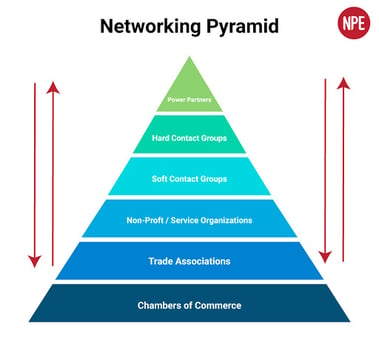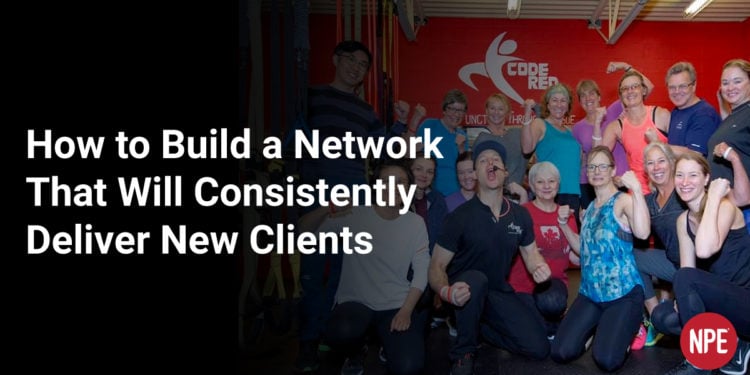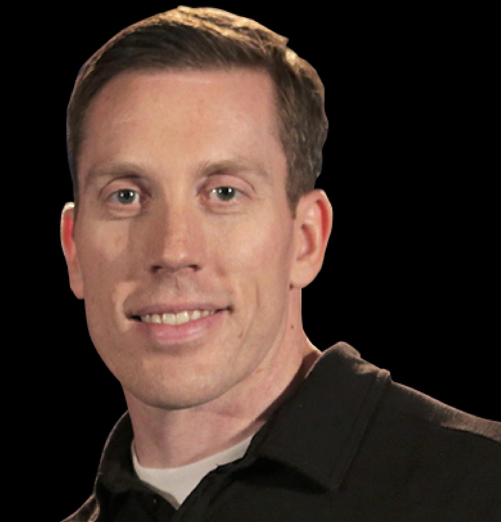The strength of your business is equal to the strength of your network. Here’s what I mean…
Many fitness professionals and personal trainers invest huge amounts of time learning their craft. They work hard to get certified, and then want to get down to business training clients….
… and hit a wall.
They discover that their personal training career takes off ONLY AFTER they learn to cost-effectively market their services. And in most cases that means ‘word of mouth’ and networking (online and offline). But what if you don’t have a network? And you have no idea how to build one or use it effectively?
Here are 3 steps to get you moving forward FAST:
1. Understand what your network is (and is not)
Networking should be your first low-cost, high-impact strategy for generating new leads, referral sources, revenue streams and strategic partners. But before you begin, what exactly is networking?
It’s NOT net-eating… It’s NOT net-sitting around… It’s NOT net-selling… And it’s NOT net-meeting people… It’s net-WORKING. It’s a marketing strategy you use to build new relationships and strengthen existing ones.
Your goals in networking are to identify and develop referral partners, build your list of contacts, gain new clients (directly), and become THE go-to person in your fitness niche that people think of when they want to recommend services to their friends, colleagues, and clients.
How?
Start out by assessing your existing network: you have bystanders – acquaintances you’ve met only a few times; supporters – people active in your network, whom you’re currently conducting business with (or have in the past); and producers – people who are an integrated part of your business.
You want to build these relationships (and you don’t want to damage the relationships trying to “upgrade” people from one category to another). When making contact with these people, here’s what you want to avoid:
- Trying to sell: Networking is about building contacts, connections and relationships – NOT about selling.
- Not listening attentively: Be engaged and care.
- Not offering help: Giving is the best way of getting in return; don’t show up to the picnic just looking to eat!
- Not getting involved: You need to do more than just show up at events to get results!
- Not meeting multiple times: Relationships aren’t formed in a single meeting.
- Not following up: Only 2% of people ever follow up with the people they meet – STAND OUT! (Thank you cards, phone call, email, etc.)
- Expecting immediate results: you need to build a foundation and have patience. It takes time to build solid relationships, but those relationships pay out over a long time.
2. Networking basics
and your ‘moment of opportunity’
How are you branding yourself? You are a fitness professional and business owner, not just a personal trainer. You represent your business ALL of the time. When you are networking, you want to be focused, professional, and friendly.
What you do, what you say, and how you dress either makes the right first impression or doesn’t. Be approachable, smile, bring positive energy to the room, and be excited. Avoid politics, religion, and hot button issues; take time to make other people feel important and heard.
Focus on the process. Building and maintaining relationships is a process: rapport, trust, common interests, helping & giving, positive support, accountability, and time. You are looking for a moment of opportunity. What will you say to create a conversation?
You have 30 seconds to capture attention. You do this with a quick “elevator speech” of your name, your company, values & purpose, and a success story:
- Name and company: “Hi, I’m [Name]. I own Get Strong Fitness. We offer personal and group training focused on losing weight and increasing quality of life.”
- Values & purposes: “We believe in integrity, fun, accountability, and instilling pride in everyone’s lives. Our purpose is to bring excitement and energy to the greater ‘Anytown’ community one workout at a time.”
- Success story: “I have had the opportunity to work with amazing people that have literally changed their lives in ways they never thought possible because they took charge of their health & fitness, and started to believe in themselves. Three of my clients just completed their first marathons at ages 37, 41, and 29!”

3. Where to network

Build your network in layers. Strengthen your local contacts, your industry contacts, and service organizations. This allows you to meet many people, learn new ideas, engage in public speaking, and do good work while building relationships. It gets your name out there.
Your next set of layers connect more and more directly to your business. It’s like a pyramid, and the top is strategic alliances with partners who will provide a steady supply of good leads.
The pyramid looks like this:
- Chambers of Commerce
- Pros: Frequent meetings, large numbers of people and many different ways to get involved.
- Cons: Not always focused on results and can be hard to know the best way to get involved.
- Associations
- Pros: Monthly and quarterly meetings; industry specific and common interests; can stand out; and can be a bridge to speaking opportunities and clients.
- Cons: Associations have specific agendas unrelated to business.
- Service Organizations
- Pros: Frequent meetings, small group of people, local businesses, focused on service.
- Cons: Not directly about business.
- Casual soft contact groups Examples: Toastmasters, Jaycees, WOMTEC.
- Pros: Frequent meetings, small groups, easier to develop relationships; mix of business and social.
- Cons: Not always focused on results and can be more social than business.
- Hard contact groups Example: BNI.
- Pros: Focused on business; training and education available, locations all over, frequent meetings.
- Cons: Not instant results; need to find the right group.
- Strategic alliances/power partners: You should be meeting constantly.
- Pros: High level, qualified referrals, consistent referrals.
- Cons: Takes time to find the right people, self-driven.
Now, once you go to a meeting, how do you make a connection?
1. Always go in with a plan. Don’t just show up at an event and sit quietly as you wait for the event to end. Have an action plan: Why are you going to this event? What do you want to achieve? How can you contribute? How will you measure success? What prep work do you need to do?
2. Follow-up right away. Very few people follow up, so you’ll immediately stand out as someone who is focused and ready to take action. Use handwritten notes, emails, texting, and phone calls to begin new relationships and when it’s right, set up one-to-one meetings.
3. Structure your networking plan to find and regularly meet with strategic partners. These are people who are non-competitive but serve the same clients you do, such as physical therapists, chiropractors, and nutritionists who can refer you clients. Strategic partnerships are a result of your actions–they don’t just happen. You must invest the time.
4. Block time in your calendar for networking. If it’s not on your calendar, it won’t get done. Commit to one hour a week to build a plan for network. Commit to attending one outside group event a week. Block one hour a week for follow up and connecting after events. And schedule a MINIMUM of one hour a week for weekly meetings with strategic partners (or networking to develop them).
Summary
Networking is the most cost-effective source of referrals and the first place personal trainers should start in generating new training leads and finding new personal training clients. Building a network doesn’t just happen–you need a strategic plan so you know how you will present yourself, who you want to target, how you can help others, and how you’ll follow up. Block time in your calendar, go to outside events, find strategic partners, and nurture relationships as part of your strategic marketing plan.
Want to learn how to attract more personal training clients? If so, register for NPE’s free eCourse: Start Your Own Fitness Business: Turn Your Passion Into a Business Earning $10K/Month. You can find a link here.

















